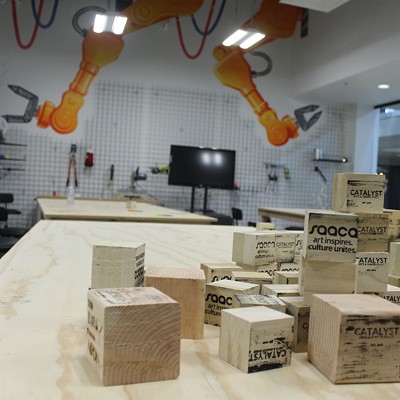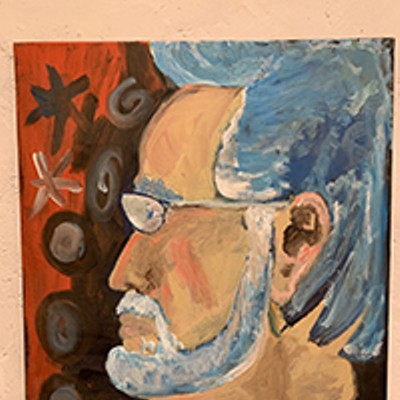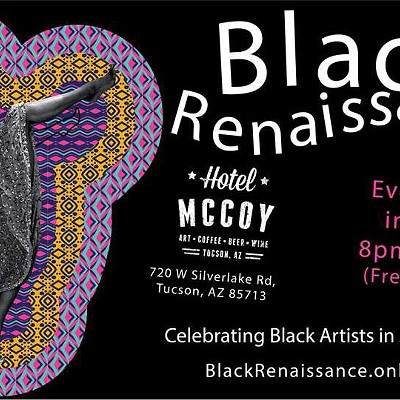The venture launched what is now known as Club Congress.
"We all got to be performance artists by virtue of opening the door. There was no end to our excitement and enthusiasm. We were young," says Brazil, now 45 and still a downtown resident.
Brazil and Gary Patch, also from Minneapolis, both got jobs as desk clerks the year before at the venerable downtown Hotel Congress. They began to drum up ideas for the new performance space they dubbed The Counter Club. Patch, now 53, remembers the hotel's ambience.
"It was kind of a fleabag hotel. There was a wonderful group of old people who lived there. The club space was just a bunch of retail shops frozen in time in the '40s or '50s. There was a little diner in there with a low, eat-in counter."
That counter would soon become the focal point for the new club. Patch and Brazil offered up plans to the hotel's owners, Richard and Shana Oseran.
"Our original idea was to start a restaurant," explains Patch. "They weren't very excited by it. So instead, we started the Saturday night performance space with a stereo and cheap lights. We invited people willing to dance on that low countertop. The first night, 400 people showed up to see what we were doing--in the middle of the summer in Tucson."
Brazil adds, "We really had no financial resources. We were making $4.25 an hour as desk clerks. But we had huge mental resources."
After that first successful night, Patch and Brazil spent a few months remodeling the place, knocked out the walls dividing the tiny retail shops, added a dance floor and opened in time for Halloween.
"The themes changed weekly, so we were always redecorating," says Patch, who has made his living in Tucson as an interior and graphic designer. "But at the time, this was my life. We'd spend all week repainting the place, getting it ready for our Saturday night party. We had a rodeo night with horses in the lobby. We'd give discounts if people came in costume. One night was polka dot night with, of course, polka dancing."
They addressed political issues, too.
"We had Red Night to commemorate the fall of the Soviet Union. We invited someone to read from Mao's Little Red Book--atop the counter."
That was Brazil's brainchild.
"And we had Shoes for Imelda night, where people would bring a pair of shoes, and we'd pack them all up and mail them to the Philippines," Patch offers.
The hotel's regulars responded to this new performance scene with typical indifference.
"The old people were wonderful but crabby," says Brazil, who ultimately worked at the hotel for 15 years before leaving in 1999.
"This one lady would come up to me at the desk and whine about making sure she could watch The Golden Girls on the lobby's TV. Suddenly, there were lots of young people coming through the hotel. The TV eventually moved upstairs to the communal room."
The club's core group--Brazil and Patch along with Robert Bray and Vincent Alger--kept things going for three years. In the late-'80s, the energy of the Counter Club shifted drastically.
"We were hit with AIDS," explains Patch. "My boyfriend got sick and died in '87. I got on a train bound for D.C. that summer. Then I retreated back to Minneapolis for three years. I returned to Tucson in '91."
By then, Brazil was managing the hotel, and her husband, Danny Vinik, had been booking live bands for the club. The lunch counter was removed, and the name changed at some point to Club Congress.
Gary Patch acknowledges the legacy of the 85-year-old hotel, aside from its kitschy John Dillinger connection.
"I always think of this hotel as the cultural epicenter of downtown. It represents a stronghold of individualism. I like that it's still run by the Oseran family."
The hotel figures as the anchor in any talk about downtown regeneration. Patch wonders how things might change.
"There's always an air of expectancy. I'd rather see downtown stay as funky as it is than commodified like so many other cities. How many San Diegos or Denvers do we need?"
"If anything can span a bridge between the bohemians and the SUV crowd, well, it'll probably be Hotel Congress," he surmises.
Patch's and Brazil's 1980s Counter Club is not going unnoticed as a contribution to the hotel's potential coalescing role. Mirroring their own nascent playfulness, a portrait of Patch was commissioned by the hotel's owners to hang permanently in the lobby. Tucson artist Dougie Weber has come up with a different slant for the whole show.
"The collection of oil paintings that will go on display is called Showdogs, and Gary's portrait is The Man Among Dogs," explains Weber. The small paintings capture headshots of Patch's three dogs--all with vibrant, solid backgrounds, while his own sports a fanciful, geometric backdrop.
"None of them are stodgy or pretentious, like those images commissioned for banks--those dark oils of unsmiling men seated in front of rippled velvet backdrops," adds Weber, who paints dog portraits professionally.
Patch shyly admits, "I never wanted to be the center of the exhibition. So, I suggested that we just focus on my dogs. Chu Cho, my Mexican hairless, is in fact, going to steal the show."
Paralleling the zany early years of Club Congress, nee The Counter Club, Patch adds, "It wasn't about a job. It was about the music and the creativity and art. We were living the bohemian dream. As a consequence, it's given me a sense of place and history."












